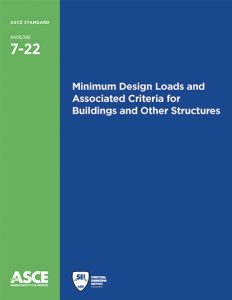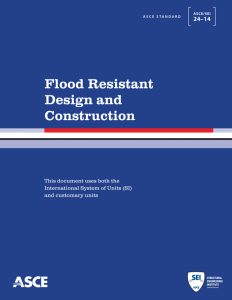What You Always Wanted to Ask
This quarterly article addresses some of the questions received about structural standards developed by the Structural Engineering Institute (SEI) of the American Society of Civil Engineers (ASCE). Following are some questions received by SEI and responses to clarify the provisions. Questions from engineers, building officials, and other design professionals are often considered to develop future standard editions.
ASCE/SEI 7: Minimum Design Loads and Associated Criteria for Buildings and Other Structures
When was the first ASCE 7 standard published?
Q: I am researching historical document requirements, and on one of my projects, it referenced ANSI 58.1 for roof, wind, and snow loads. The ANSI document seems to have been replaced by the ASCE/SEI 7 standards book. Is this correct? If so, what year did that happen?
A: Yes, the final ANSI version of A58.1 Minimum Design Loads for Buildings and Other Structures was published in 1982 and was replaced in 1988 by ASCE 7 Minimum Design Loads for Buildings and Other Structures as ANSI/ASCE 7-88. ASCE, and then SEI, has been developing ASCE 7 ever since!
How are environmental temperature changes supposed to be included in the load combinations for strength design?
Q: According to ASCE/SEI 7-22 Section 2.3.4, “Where the structural effects of self-straining forces T (environmental temperature changes) are expected to adversely affect structural safety or performance, T shall be considered in combination with other loads.” And the Commentary states, “Self-straining forces and effects should be calculated based on a realistic assessment of the most probable values rather than the upper bound values of the variables. The most probable value is the value that can be expected at any arbitrary point in time.” Two combinations are presented, both involving only Dead and Live Load. Therefore, is it necessary to combine temperature load with wind load? If so, which are the combination factors? Furthermore, is it necessary to combine temperature load with wind load AND live load? If so, which are the combination factors?
A: With regards to the load combinations in Commentary C2.3.4, an example is given for when T is the principal load and when it is the arbitrary point-in-time load (see Table C2.4-1) so that
- T is the principal load in this combination: 1.2D + 1.2T + 0.5L, and
- T is an arbitrary point-in-time in this combination: 1.2D + 1.6L + 1.0T.
This section also states, “These combinations are not all-inclusive, and judgment is necessary in some situations. For example, where roof live loads or snow loads are significant and could occur simultaneously with self-straining forces and effects, their effect should be included. The design should be based on the load combination causing the most unfavorable effect.”
This commentary refers to the load combinations in Section 2.3.1, where T can be added to other load combinations as appropriate.
What is the difference between NAVD88 and MHW in the ASCE Tsunami Design Geodatabase?
Q: My company has a design project in Hawaii. It involves exterior piping and supports that fall within the tsunami inundation zone. I am trying to identify the water depth at our design location. The ASCE Tsunami Design Geodatabase online tool indicates a Mean High Water (MHW) runup elevation, but no NAVD88, North American Vertical Datum of 1988, runup elevation. How can the MHW value be related to the NAVD88 datum, and why is this not included in the Geodatabase?
A: The NAVD88 vertical datum is only available for the North American contiguous states. All figures in ASCE 7-22 have been updated to include MHW. Alaska and Hawaii have no NAVD88 references but rely on Mean High Water, MHW. Therefore, the ASCE Tsunami Geodatabase only lists elevations relative to MHW for Hawaii. You can use the geodatabase to determine your site’s elevation relative to MHW. Alternatively, you can use other sources for the elevation. Once you run the Energy Grade Line Analysis (and site-specific inundation modeling, if required), the flow depth determined from those analyses will be relative to the actual ground elevation at your site.
Where are the underlying data for the seismic values in the ASCE 7 Hazard Tool?
Q: Would you please direct me to the raw data used to develop the maps in ASCE 7-22 Chapter 22 shown in the ASCE 7 Hazard Tool? Is it still the same data used for ASCE 7-10 or ASCE 7-16?
A: The seismic values in the ASCE 7 Hazard Tool are from the United States Geological Survey (USGS) Webservice and are included in ASCE 7-22 Chapter 22. They are available at https://earthquake.usgs.gov/ws/designmaps using the 2020 NEHRP, National Earthquake Hazards Reduction Program, link. The USGS will be adding a link directly for ASCE 7-22 as well. Additionally, per the link provided in ASCE 7-22 (www.usgs.gov/programs/earthquake-hazards/hazards), the USGS has developed information to provide more background information on their process and the data. Furthermore, the USGS explains how the seismic hazard models are updated each cycle to develop the underlying data used in each cycle of ASCE 7. And no, the data for ASCE 7-10 is not the same as for ASCE 7-16 or ASCE 7-22.
How is wind load on elevated building components calculated?
Q: Which section of ASCE 7 should be used for the wind load on a stair landing connected to a raised building? If the landing is flushed with the floor of the elevated building, should it be designed as a canopy?
A: Elevated buildings are now covered in the ASCE/SEI 7-22 version of the Standard. Section 30.3.2.1 Bottom Horizontal Surface of Elevated Buildings is the best resource to determine the wind pressures on this stair landing.
When do glazed openings need to be designed for tornado loads for Essential Facilities?
Q: If an Essential Facility in a Tornado-Prone region is determined to have tornado speeds, VT, that do not require design for tornado loads per Section 32.5.2 in ASCE 7-22, do the glazed openings for that facility still need to be protected in accordance with 32.12.3?
A: The answer is no. Per Section 32.5.2 Design For Tornado Loads Not Required, if VT < 60 mi/h, design for tornado loads shall not be required.
ASCE/SEI 24: Flood Resistant Design and Construction
Is fiber mesh reinforcement prohibited in Coastal High Hazard Zones per ASCE 24?
Q: What is the requirement in ASCE 24-14 for fiber mesh reinforcement in concrete slabs in Coastal High Hazard Zones? The provisions appear to be a blanket prohibition on any type of reinforcement in these ground slabs. Would you please clarify where fiber mesh is permitted?
A: ASCE 24-14 Section 9.3 Concrete Slabs permits two slab options in Coastal High Hazard Areas: 9.3.1 for frangible slabs and 9.3.2 for self-supporting structural slabs. For frangible slabs, reinforcing shall not be used. For self-supporting slabs, there is no restriction imposed by ASCE 24-14 on reinforcement type. The intent of ASCE 24-14 section 9.3 option 1, such as for frangible slabs, is to promote failure of a slab in such a way that an undermined slab would break into small pieces. Micro-fiber reinforcement could meet this goal since its use is intended to prevent small cracks in the slab surface and since its use would not likely prevent the breakup of the slab if undermined. However, using fiberglass mesh or similar as a replacement for reinforcing steel or welded wire mesh may prevent this performance goal from being reached. The Authority Having Jurisdiction would need a closer review, depending on the exact fiber mesh proposed. A fiber mesh that prevents slab breakup would not satisfy ASCE 24-14 Section 9.3, option 1. However, local or state floodplain management regulations may limit the use of option 2 in some circumstances, and Section 6.9 of the National Flood Insurance Program (NFIP) Technical Bulletin 5-20 Free of Obstruction Requirements discusses the same two options.■
If you have a question you want to be considered in a future issue, send it to sei@asce.org with FAQ in the subject line. Visit asce.org/sei to learn more about ASCE/SEI Standards.
This article’s information is provided for general informational purposes only and is not intended in any fashion to be a substitute for professional consultation. Information provided does not constitute a formal interpretation of the standard. Under no circumstances does ASCE/SEI, its affiliates, officers, directors, employees, or volunteers warrant the completeness, accuracy, or relevancy of any information or advice provided herein or its usefulness for any particular purpose. ASCE/SEI, its affiliates, officers, directors, employees, and volunteers expressly disclaim any and all responsibility for any liability, loss, or damage that you may cause or incur in reliance on any information or advice provided herein.


